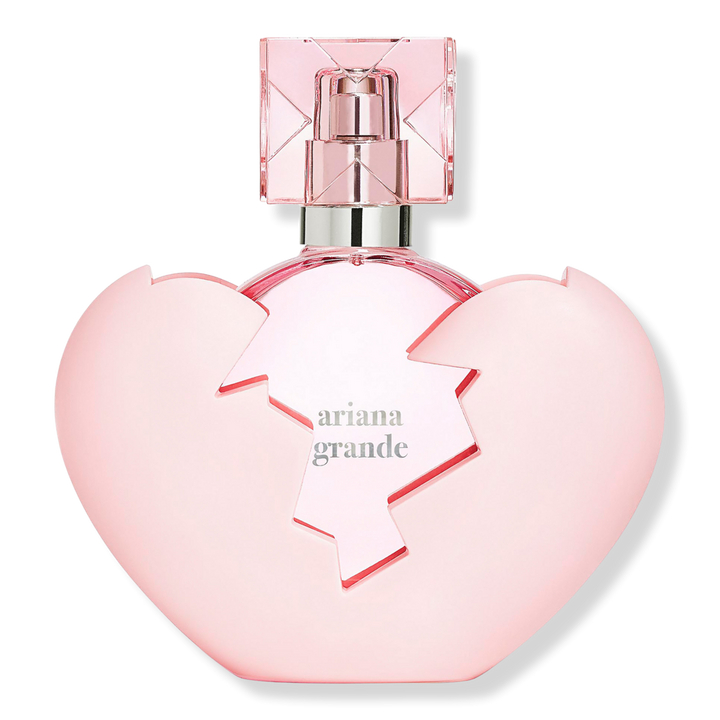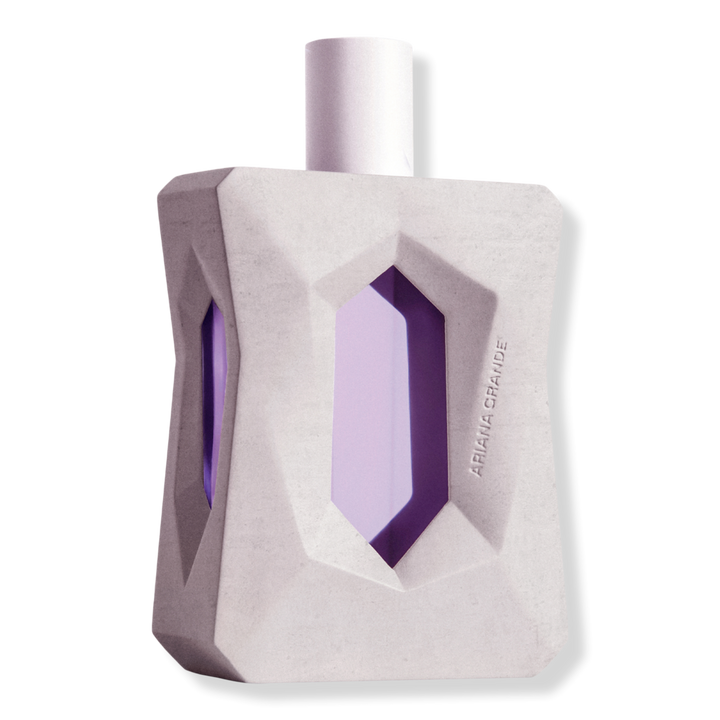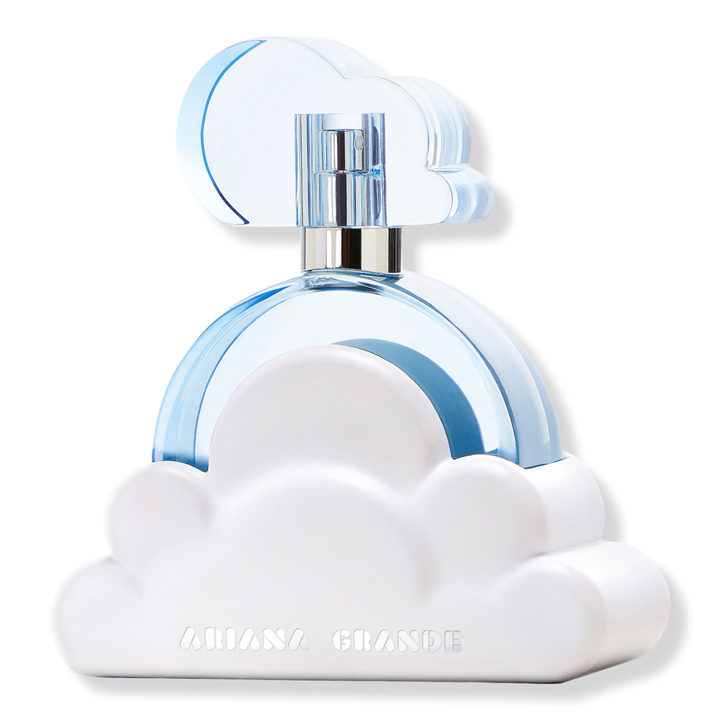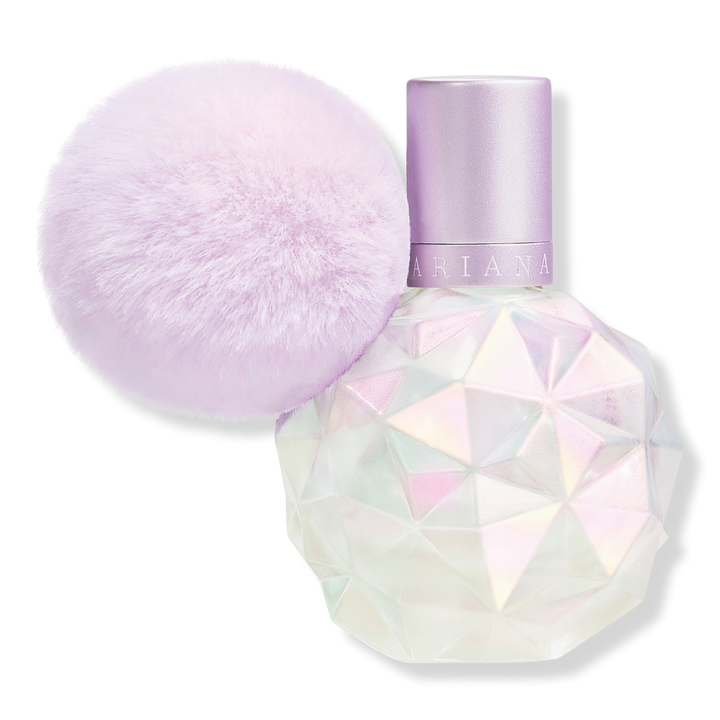Ariana Grande Is The Last Great Celebrity Perfumer
Ariana Grande released her fourth studio album, Sweetener, in August of 2018. It was her first to feature a colorful album cover and to show the singer sporting a low ponytail—a seemingly small change, but significant for an artist like Grande whose previous work had presented such a meticulously crafted image (consider that she once was rumored to refuse to be photographed on her right side). A month later, Grande released her fifth fragrance, called Cloud. Housed in a clear blue bottle encased in a white plastic cloud, it was the first of her perfumes to deviate from the faceted spherical design of the four previous ones.
In both Sweetener and Cloud, Grande sent a clear message: Maybe you had her pegged as a wildly successful but formulaic pop star, but she was just getting started. She was going to show you what she could really do—and that included making some really damn good perfume.
When Grande partnered with Luxe Brands to release her first fragrance in 2015, she was jumping into a market well past its peak. Celebrity perfume lines from her predecessors like Rihanna and Katy Perry had drifted into unmemorable releases; Taylor Swift had already given up the game a year prior. Grande’s A-list counterparts have since taken to launching high-end skincare faster than you can shake a sheet mask at them. Perfume is a surprisingly old-school strategy for bolstering the image of a young pop star, but it works for Grande, not only because her fragrance storytelling is so sharply aligned with her musical stardom, but also because her fragrances, bolstered by Cloud’s runaway success, are hyped enough to command a fan base wholly unconnected to hard-core Arianators.
And that’s no easy feat, considering celebrity perfumes rarely attract buyers outside their core fan bases. As The New York Times perfume critic Chandler Burr noted in a (glowing) review of Britney Spears’s Midnight Fantasy, celebrity perfumes can be a tough sell due to their image as tasteless money grabs. “It may also be that much of celebrity perfumery is unadulterated garbage,” he added.
But there are exceptions to every rule. “Ariana aside, celebrity side, I would pick up Cloud in any other bottle from any other brand and love it as much as I do,” says Tynan Sinks, a beauty writer and the cohost of perfume podcast Smell Ya Later, where his love of Grande as both the music megastar and fragrance entrepreneur is a frequent topic. “It’s sort of like her [musical] talent. You don’t have to like it, but you can’t deny that it’s good,” he adds.
Sinks was interested in Grande’s perfume from the beginning, though he acknowledges they weren’t standouts early on. “Her first four I want to say were pretty run-of-the mill celebrity scents. They were fine. They were cute,” he says. But with those four, Grande was able to establish her credibility in the fragrance sphere early in her music career. When she launched Ari in 2015, a juicy rose marshmallow scent, she had two successful albums out, but was also just a year out from the end of her Nickelodeon shows and still shaking off her image as a children’s TV star.
Her second fragrance, 2016’s limited-edition fruity, peppery scent, Frankie, was forward thinking in that it was marketed as unisex—all fragrance is unisex if you want it to be, but labeling them as such was, and still is, a rarity in the celebrity and designer perfume genre. Sweet Like Candy and Moonlight followed in 2016 and 2017, respectively, both sweet, fruity florals like Ari. By 2017, she already commanded $150 million in fragrance sales. A job well done, but they weren’t products you’d take notice of unless you were explicitly looking for celebrity perfumes. “It really did all change when it got to Cloud,” Sinks says.
“With Ariana, she’s always looking for a new addiction. Something that’s gonna resonate with her and make you smell it over and over,” Firmenich perfumer Clement Gavarry, the nose behind Cloud, says. When Gavarry came to work on the scent, he’d already made a number of successful perfumes across the niche and designer spectrums, perhaps most notably Lovely by Sarah Jessica Parker, a chic 2005 creation so beloved it isthe subject of an entire book
Working with a celebrity is like working with any other client, Gavarry says. Albeit with Grande, that client comes with a more devoted set of consumers. “After two or three [perfumes], maybe the consumer or the fan base of the celebrity would be like, ‘I’m getting tired of it,’” he says. “But with Ariana, there’s never a question. Her fan base is so dedicated.”
.
Those fans were ready for something different. With Cloud, they got a lactonic, whipped-coconut musk confection. What makes Cloud Cloud isn’t any single discernible note, but rather its enveloping, cozy quality. “It’s very memorable, very recognizable in the street. Whoever’s going to wear it has a big trail. There’s a big longevity. And that’s a very good sign for creating a timeless fragrance,” Gavarry says. In short, people are going to notice it on you, and they’re going to ask you what you’re wearing, and that’s as key a component as any for a fragrance to garner a cult following.
The following year, Cloud won The Fragrance Foundation’s Fragrance of the Year in the Women’s Popular category. And it has only picked up steam since then. A bottle of Cloud reportedly sold every 11 seconds. Cloud is frequently held up as a dupe of a far more expensive but equally hyped scent—Baccarat Rouge 540 by Maison Francis Kurkdjian. How alike the scents are is debatable depending on who you ask, but the mere comparison to a $325 perfume speaks to the surprising sophistication of Cloud, which costs just $45 for a one-ounce bottle.
“Cloud makes me feel smart, capable, and effortlessly chic. Like someone who’s reached inbox zero. Like someone who doesn’t have an old beef stew Tupperware rattling around in her workbag,” Ariel Dumas, head writer and producer for The Late Show with Stephen Colbert, says. Dumas says she didn’t have many feelings about Grande as a pop icon; she was more familiar with her occasional celebrity antics like allegedly demanding she be carried around like a baby by a bodyguard (“I remember folks on Twitter saying, ‘Why on earth would you deny a move so powerful, so baller?’ I felt the same.”). She came across Cloud’s many positive reviews when searching for new fragrances at the onset of COVID and was immediately hooked, recommending it to everyone who asked.
“During the pandemic lockdown, I really got into collecting sample fragrances, as inspired by journalist Rachel Syme’s tweet series, ‘Perfume Genie.’ This sounds silly, but trapped in a small apartment, I had so little sensory input. Smelling different things was a form of mental escape,” she says.
Dumas is certainly not unique in that aspect. “The fragrance category was on fire throughout the pandemic, and that momentum has only continued,” says Monica Arnaudo, chief merchandising officer at Ulta Beauty, which has been the exclusive retailer to launch Ariana Grande Fragrances since 2018.
Post-Cloud, Grande’s fragrances have become both more daring in their scents and packaging, and more melded with her music, with each scent named for songs in her catalog, such as R.E.M. (an airy lavender scent with a trendy fig note). Her 2019 scent, Thank U, Next, not only built on Cloud’s popular coconut note, its ad campaign playfully repurposed the Mean Girls-cum-Bring It On music video for the song of the same name. This is not the simple perfume product placement in Spears’s “Circus” music video a decade earlier: In the Ariana Grande empire, fragrance gets a starring role.
Her most recent launch, God Is a Woman, was created by Jerome Epinette, the nose behind many Byredo hits like Bal d’Afrique, and responds to the demand for “clean” fragrances, composed of 91 percent naturally derived “clean” ingredients. “I think the celebrity fragrances have evolved a lot,” Gavarry says. “That perception has evolved so much. Now people seem to want to develop fragrances more about the quality of the product than selling the fragrance.”
Younger consumers are also more discerning, particularly as PerfumeTok introduces a wider audience to fragrance. “Beauty consumers’ interest in fragrance has grown as well, with many younger guests engaging with the category earlier than ever before,” Arnaudo says. “Perhaps one of the biggest trends we’re seeing are guests wanting more than a signature scent and are now building their fragrance wardrobe to match their different moods and feelings.” New perfume shoppers seeking out affordable, hyped-up scents will find a whole catalog of Ariana Grande scents to choose from, with endless TikToks and YouTube videos dedicated to reviewing her collection. According to U.K. platform Hey Discount, Grande’s fragrance line is the most-searched celebrity offering, with 4.4 million searches across Google and social media platforms per year. Billie Eilish trails in the number two spot with just 1.3 million.
Grande’s dominance in the fragrance space stands in contrast to the stiff competition she faces in celebrity cosmetics, where lines like Selena Gomez’s Rare Beauty and Rihanna’s Fenty dominate. At its launch in late 2021, Grande’s R.E.M. Beauty didn’t hit the scene with its own version of Fenty’s inclusive foundation shade range or Rare Beauty’s pigmented liquid blush; Grande herself didn’t have an established reputation for doing her own makeup (like Halsey did when they launched About Face). Not only that, R.E.M. arrived when consumers were already more than satiated with celebrity beauty lines. “I do think she came late to the game,” Sinks acknowledges. The response from influencers and critics wasn’t overwhelmingly positive at first. However, R.E.M.’s new concealer—aptly called Sweetener—connected with the beauty community this summer. Grande’s makeup could still find its footing in a year or two, following the same path as her fragrances.
Celebrity products in general are the result of many different parties—the licensing companies producing the product, a fragrance company and nose who develop perfume, et cetera—which can easily lead to a fractured product in which the connection to the celebrity is all but superficial. “Once I was part of a market research focus group for what was then Beyoncé’s first perfume,” Dumas recalls. “They didn’t let us smell the perfume. We were all astonished. They only cared about what kind of bottle and packaging we associated with Beyoncé.”
A through line in many of the more successful perfumes in the genre, from Britney Spears’s line to Parker’s Lovely, is the investment of the celebrity in the actual scent. “Ariana is very involved in the creation and also to sell them,” Gavarry says of working with her brand. “That is amazing for us perfumers. And she has also quite a nice knowledge about the wording to describe fragrances, which makes the life of a perfumer much easier.”
But it’s not a matter of the scent being good or the storytelling matching the celebrity’s aura: The fragrances that transcend the genre need both. A large part of Grande’s appeal is that her image is not entirely unfamiliar: Her Barbarella-infected styling plays on recognizable references. It’s naughty but safe at the same time, and thus utterly irresistible. And you could say the same about her fragrances. “Her brand is really tight and always has been,” Sinks says. “Everything that Ariana does is so closely tied to what she loves and how she sounds. As she has grown and matured as an artist and a woman, so have the fragrances.”
The celebrity product market is always evolving; Eilish is nipping on Grande’s heels with her second perfume out this year. But whether celebrities are selling a face serum or a perfume, they are always selling a fantasy. “It’s like wanting to own a piece of somebody, and wanting to feel like they see us,” Sinks says.
Like her music, Ariana Grande’s fragrances are poppy, infectious hits that are hard to put down. And, like her songs, they’re everywhere. Even if you don’t know it, you’ve already smelled an Ariana Grande perfume. And you probably already like it.







